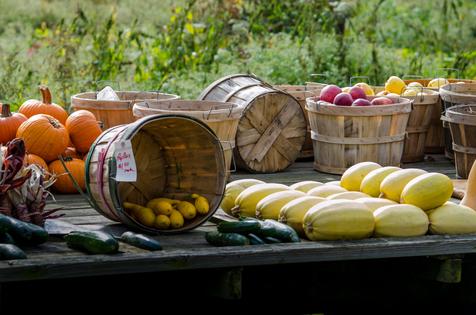Environmental Nutrition: The benefits of fall produce
Try seasonal produce for a boost of tasty goodness!
Along with the changing colors of the leaves and the fall season comes delicious produce packed with nutrients. Heading to the local market and choosing a colorful assortment of fruits and vegetables is a great way to encourage good eating and nutrition. Local farmers' markets can provide access to seasonal crops, especially in remote areas, and can be a great resource for purchasing fall fruits and vegetables. Produce from local farmers tends to be freshly harvested, often resulting in better flavor and higher nutritional value than food that was picked days or weeks ago. Supporting local businesses like farmers markets, farm stands, and Community Supported Agriculture (CSA) programs can help shoppers get to know neighbors and feel a part of a larger group.
Benefits of fall produce: top picks
Whether shopping at the local grocery store or farmers market, autumn is a great time to incorporate and try new seasonal fruits and vegetables. Here are some fall favorites:
Beets: Beets are 100 percent edible all the way from their leafy greens down to their roots. Although typically red, beets may also be golden yellow or "candy cane." Beets are rich in nitrates, which convert to nitric oxide, and may help dilate blood vessels and reduce blood pressure. Roasting or steaming beets is an easy way to cook them and they can also be enjoyed raw, shredded and tossed in salads. In addition, the leafy greens of beets resemble spinach and kale and are delicious sauteed.
Sweet potato: Along with their deliciously mild flavor, sweet potatoes are chock-full of nutrients including fiber, potassium, vitamin C, vitamin E and beta carotene. They are naturally sweet and taste great when roasted, baked or mashed, and they typically do not need the sugar and butter that often accompany them. Boiling sweet potatoes helps them to retain more beta-carotene and improves the nutrient absorption better than other cooking methods such as baking or frying. Cooking with the skin on further helps to minimize leaching of nutrients including beta-carotene and vitamin C.
Apples: An apple a day may truly help keep the doctor away. This fall favorite is rich in fiber and provides vitamin C and various antioxidants including quercetin, catechins and chlorogenic acid -- which have been found to have a variety of health benefits. Research has shown that eating apples may help reduce the risk of heart disease as well as colon, liver, prostate and lung cancer. Animal studies have suggested that antioxidants, specifically quercetin, in apples may sharpen memory and learning and protect against oxidative damage that contributes to Alzheimer's disease and other age-related brain disorders. Enjoy one plucked right off the tree, or with further preparation and baked, boiled or pureed.
Pumpkins: Although fun to decorate, pumpkins are also a highly nutrient-dense food packed with fiber, potassium and a wealth of antioxidants including vitamin C, vitamin E and beta-carotene. Consuming foods rich in beta-carotene may reduce the risk of certain types of cancer, offer protection against asthma and heart disease, and delay aging and body degeneration. Pumpkin can be pureed and added to smoothies or soup, or used as a fat replacement in baking recipes. In addition, pumpkin seeds are a good source of magnesium and zinc, and can be enjoyed toasted or roasted in the oven.
(Environmental Nutrition is the award-winning independent newsletter written by nutrition experts dedicated to providing readers up-to-date, accurate information about health and nutrition in clear, concise English. For more information, visit www.environmentalnutrition.com.)







